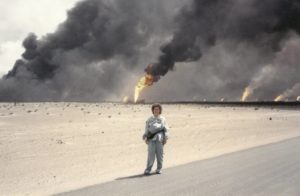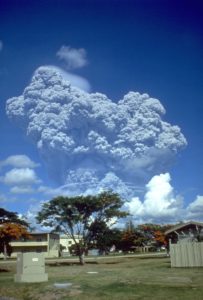
In my first post in this series on climate change, I mentioned the amount of volcanic ash in the atmosphere as a possible cause of global warming. I asked if global warming was in part caused by a reduction of volcanic activity over some period of time. I looked for an answer to that back in 2018-19 when I did my studies into this topic, and found nothing about it.
You might wonder why this came on my radar. The answer is what I observed in Kuwait in 1991. Those old enough will remember that Iraq, as they realized they were losing Kuwait and about to withdraw, set Kuwait’s oilwells on fire. When the US moved into the just-liberated country, they found an environmental disaster in progress. As soon as the country was secured, oil fire fighters from around the world, but especially from the USA, went to work on the fires in Kuwait. But within a couple of years, the ash was gone, the temperatures were back to normal.
The fires started around Feb 25, 1991. I went back to Kuwait in early July 1991. Some of the fires had been put out at this time, but many, possibly most, were still burning. I noticed that the ambient temperature was much lower than during my previous years in Kuwait and the Gulf region. Maybe as much as 10-15°F. Why? The ash in the atmosphere was clearly the reason.
I paid attention to this for a while. The plume of smoke was blown southwest by the dominant winds, though sometimes to the south. Areas downwind also experienced lower than normal temperatures. It took months to get all the fires out, and the lower temperatures persisted even beyond the time the last fire was out.

This stayed in my mind. The global warming (later rephrased as “climate change”) debate was just getting started at that time. As the debate built over the years, I read what I could about it. Those most vocal were, in general, people who I didn’t think very highly of. This made me skeptical of their arguments.
However, as I said in the first post in this series, it is intuitively obvious to me that mankind’s activities today produce heat compared to mankind’s activities, say, two or three or ten centuries ago. The question becomes, how much of the global warming is being caused by mankind and how much, if any, is being caused by natural causes that mankind has no control over?
As I gave this a lot of thought, I also took note of the “mini-ice age” that was observed in the 1960s and 1970s. This was a time of colder than normal temperatures in the USA and elsewhere. That ended somewhere in the first half of the 1980s, and average temperatures going up. Don’t remember the mini-ice age? You should be able to find out something about it by a simple internet search.
To me, the cause of the mini-ice age and the eventual end of it were obvious. The cause was particulates emitted into the atmosphere by industrial activity. The end of it was the result of changes in emissions brought about by the Clean Air Act (and similar actions in other countries). Passed in 1969, it took a while to retool our industrial infrastructure to reduce emissions. That began to take hold more and more each year after we began to address our crass treatment of the world we live in and the air we breathe.
Sometime in the early 2000s, these different things came together in my mind. Dump a bunch of pollutants into the atmosphere from smokestacks, lower the temperature. Stop doing that, raise the temperatures. Dump a bunch of oilwell fire ash in the atmosphere, lower the temperatures. Put the fires out, raise the temperatures.
That led me to think about volcanic activity and I wondered, are there different periods of increased and decreased volcanic activity, and might that be a contributor to climate change as the activity increases or decreases? In 2018-2019ish, I began to look for answers to this question, the internet being my main library.
Great reductions in worldwide temperature were experienced after major volcanic eruptions. 1815, 1883 (Krakatoa), 1991 (Mt. Pinatubo) were all major eruptions that resulted in global cooling. The effect lasted for years.
What about the less major eruptions? Have we tracked those, and do we have a database that shows the amount of volcanic ash disgorged into the atmosphere? And can this activity be correlated to changes in the climate? I looked for this information, even perusing the website of the organization of the organization that vulcanologists belong to, and couldn’t find it. As I said in the first post in this series, perhaps the information was available and my research techniques were at fault.
But thanks to a cousin, who posted about an article by the University of Cambridge (England), I now have access to a scholarly article about this. It was posted 12 Aug 2021, so after I did my searching. I’m quite glad to know that others are thinking about this.
This is a long, long article, filled with technical language that I’m wading through. It’s going to take me a while to digest it and be able to post about this. I’ll make other posts in the series, I think, before I get back to this.